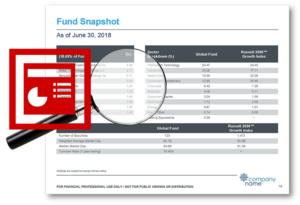What Shutterfly and PIMCO can Teach Marketers about Data Quality

If you’re like me, you worry about making marketing mistakes that might reflect negatively on your company’s brand.
Marketing blunders cause embarrassment and negative PR, but they usually blow-over in time. For example, you might recall when Shutterfly sent a “congratulations on your new arrival” email to people who hadn’t recently given birth. It was a data quality issue that caused backlash from their customer base and a lot of negative press. But, everyone eventually moved on.
In financial services, however, marketing blunders are much more serious. When they are due to data errors or inconsistencies, there can be regulatory issues, fines, and liabilities in addition to bad PR. There’s even the risk of losing your job or your license.
Because financial services marketing is driven by enormous amounts of data, the risk of making a reporting mistake is extremely high. Mistakes caused by a lack of data quality can be a huge blow to a firm, causing them to lose credibility with investors and advisers.
A few months back, The Wall Street Journal reported that PIMCO inconsistently disclosed its Russian Investments in third-quarter investment reports. To add insult to injury, this happened shortly after Bill Gross left to join Janus.
According to the Journal, PIMCO Emerging Markets Bond listed the exposure as 11.3% in a fund card published Sept. 30 while listing a 2.5% weighting in a semi-annual report published the same day. It looks like the discrepancies resulted from the exposures’ being calculated by country of risk in one of the filings and by country of issuance in the other. Although this did not appear to violate securities law, the Journal reported that an expert in securities law declared that funds should be consistent in their approach to such disclosure and explain which method they use.
One thing marketers all have in common – a reliance on data quality
I don’t mean to pick on PIMCO; firms all across the industry are subject to the challenges of publishing their data accuratly. Usually, it’s a lack of a good data management system that causes reporting discrepancies and inconsistencies across marketing outputs.
It doesn’t matter if it’s customer data or product data, we rely on good information for our marketing initiatives. Without quick access to quality data, we get bogged down and risk making errors. Most marketers use technology and data to create targeted, timely, personalized, and compliant campaigns. But the data has to be reliable. Whether it’s an email campaign or a quarterly investment report, marketers can make mistakes when there’s a problem with the underlying source or the system producing the data.
Earlier this week, I had the opportunity to interview Maria C. Villar, Managing Director of Business Data Leadership, author and instructor at eLearningCurve who said, “There are usually three fundamental business drivers that compel companies to start a data management or data governance program. Those three drivers are data quality issues, legal or regulatory requirements, or internal business intelligence needs.” Investment marketers struggle with all three of these areas, so it never fails to surprise me when I hear that a firm is still moving data around in spreadsheets and emailing them back and forth. That kind of “data management” is extremely risky.
Investment marketers rely on immediate access to quality data
Earlier this week, I spoke with someone in a director-level marketing position for a very large asset management firm who oversees the production of the firm’s fact sheets, commentaries, website content, and other assets. We commiserated about the issues around data quality. This firm’s internal IT department recently built a data warehouse, but her department’s needs aren’t being met. The reporting capabilities, traceability, and controls are lacking and there’s really no way to ensure that the data being pulled will be consistent from one day to the next. What happened to PIMCO could easily happen to this firm. Even slightly different data in different reports can cause a regulatory red flag. There has to be some process or system that defines a point in time where that data becomes “final” and gets the green light for marketing use.
The investment marketing professionals I talk to seem to all have a very similar story:
- We aren’t (and don’t want to be) the data experts. How can we be sure this data is even reliable? If I pull the report today, will it be the same if I pull it tomorrow?
- I need to be able to pull my own reports or get them on demand. If I put in a reporting request, how long will I have to wait to get the report?
- Using Excel is risky. Microsoft Excel and email do not make a good “data management” scenario. It’s too easy for a mistake to be made.
- It takes too long for the data to arrive. It takes too long to get the data, and/or when I get the data there are problems with it. How can we possibly meet our target fact sheet release date?
So, how can investment marketers solve the data quality problem?
Marketers can start by understanding how data management impacts data quality and calling for change. This is a challenge, as this requires involving multiple stakeholders from different departments and making your case to people up the chain. However, marketers are increasingly more involved in the research, evaluation, and selection of key technologies.
Related: Make vs. Buy: Should Financial Services firms buy or build technology solutions?
In order for investment marketers to invoke change, they need to have a good understanding of their needs. A good data management system must support:
- Ease of Use – Marketers aren’t data experts. The interface needs to be simple to navigate so marketers can find what they need without running a complicated query.
- Transparency – Marketers should know the status of the data at all times (Who’s responsible for it? Where is it? What’s the deadline?)
- Workflow – Data aggregation should be automated to collect all required data files/types from disparate sources (external and internal data providers). The system should involve the data owners so that the burden is taken off of the marketing team
- Accuracy – Business rules should be used to place controls on the data and ensure numbers won’t be different from one report to the next (likely PIMCO’s issue)
- Auditing/Traceability – Proper audit trails must exist to satisfy compliance needs
- Reporting – The processed (“clean”) data should be highly accessible. Marketers should be able to pull reports as needed to create marketing materials
With the right data automation system in place that serves the marketing and client communication needs of the business; you can fix the root cause of many operational problems.
Marketing efficiency and effectiveness relies on quality data
As marketers, we are used to dealing with marketing mishaps from time to time. Some are more serious than others, but when it comes to creating campaigns or producing marketing materials based on data, quality is a big deal. Quality data is extremely important and the system(s) that get us to that quality data are vital. Simple mistakes like putting the wrong link in an email campaign are easy to fix, and easily forgivable. Mistakes that happen as a result of bad or inconsistent data can cause serious repercussions from both a brand and a regulatory standpoint. Investment firms shouldn’t have to take that credibility hit, especially when it is completely preventable with a good data management strategy.
Did you like this post? Please share! You can also subscribe to our blog.
Here are some related resources that might interest you:







 Compare the Top 3 Finserv Content Automation Vendors [White paper]
Compare the Top 3 Finserv Content Automation Vendors [White paper] Create Pitchbooks the Drive Sales [White paper]
Create Pitchbooks the Drive Sales [White paper] Build vs. Buy: Should Your Financial Services Firm Outsource or Insource Marketing Technology? [White paper]
Build vs. Buy: Should Your Financial Services Firm Outsource or Insource Marketing Technology? [White paper]  10 Tips for Rebranding your Fund Marketing Documents [White paper]
10 Tips for Rebranding your Fund Marketing Documents [White paper]




